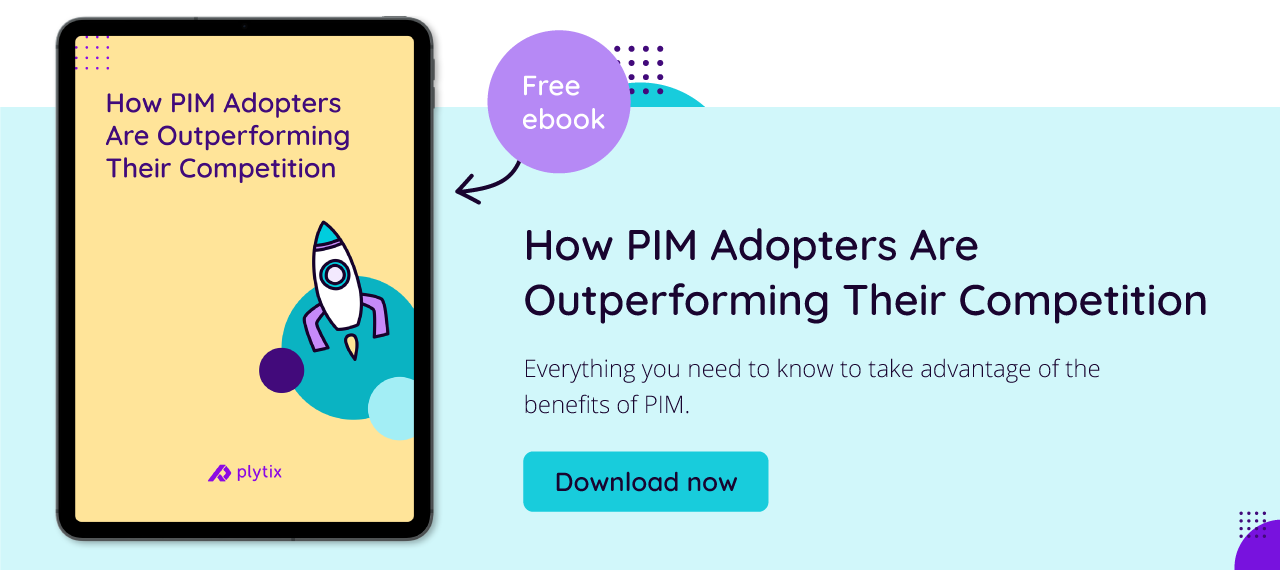What is Ecommerce Product Management?

Keep the good stuff coming
Subscribe to our blog newsletter and get monthly content that helps you manage product data smarter.
No spam. Just real value.
To quote pretty much everyone working in online retail, pretty much every online retail blog, and to be honest even previous articles written by yours truly:
“The world of ecommerce is constantly changing and expanding.”
Groundbreaking stuff, I know. Although in-person shopping seems to have more-or-less recovered since the time of certain global events that shall remain nameless, online shopping is still just as popular as ever, and continues to grow year-on-year. Basically, it would appear that consumers are choosing to make ever-increasing amounts of purchases both on and offline.
Even in the event that your customers ultimately make a purchase in a brick-and-mortar store, there’s a good chance that they’ll have come into contact with your product via a different channel beforehand. 73% of consumers make purchases through multiple channels, so a combination of physical stores, webshops, social media, and third-party marketplaces. This is probably why retailers making strategic use of multiple sales channels see a 179% increase in sales on average.
So to cut a long preamble short, no matter what your retail business is, ecommerce is going to have a part to play—I mean, it’s predicted to hit 8.1 trillion USD in sales in 2026. There are a whole lot of complications involved too though, and a massive one is simply finding a way to manage your products and their data in an efficient way.
Understanding ecommerce product management
That’s where ecommerce product management comes into play—it’s about guiding the entire lifecycle of a product, from conception to discontinuation. This practice has the noble goal of making sure your customers’ needs are met as well as possible… and generating more revenue as a result, naturally.
Efficient ecommerce product management involves collaboration between pretty much all the product-related teams in your organization—so everyone from design and engineering to marketing and sales, right through to post-purchase customer support. All these teams have to work together if they want to effectively develop, introduce, improve, and promote products, and ecommerce product management is an essential part of that collaborative process.
Efficient collaboration is always worth celebrating.
While it shares its core principles with general product management, ecommerce product management specifically targets the online shopping experience—hence that all-important ‘e’ in ‘ecommerce’. This means refining every stage of the customer's online journey, from product search and discovery to the online checkout process (and beyond). Given today's high consumer expectations for a seamless, personalized online shopping experience and super-prompt customer support, effective ecommerce product management is crucial for brands if they want to meet these demands and cultivate a loyal customer base.
What’s more, the rapidly changing nature of the ecommerce sector (which I believe I may have mentioned earlier) requires product managers to continuously monitor the competitive landscape, stay up-to-date with the latest trends in ecommerce, and stay on top of changing consumer preferences. This ongoing vigilance and ability to adapt rapidly are key for ecommerce brands looking to maintain a competitive edge (so, you know, all of them).
Key areas of Ecommerce Product Management
Now, let's get into the nuts and bolts of ecommerce product management. There are various different practices and tasks that fall under this umbrella—here are four of the most important ones:
Managing product data (a.k.a. the backbone of online retail)
This is where the rubber meets the road. Making sure that product listings are detailed, accurate, and up-to-date is a top priority—after all, this is the information that customers use to make their purchasing decisions. It's not just about having the right specs and pictures, though, it's also about using those stats and digital assets to craft an engaging narrative that resonates with your customers and compels them to hit that 'Buy' button.
Market analysis (a.k.a. your retail radar)
Staying clued in on market trends, understanding consumer behavior, and keeping an eye on what the competitors are up to isn’t just a nice-to-have—it's essential. This intel informs your product strategy and positioning, so you can make sure your products aren’t just meeting the market standards but setting them.
 Cross-functional collaboration (a.k.a. the ecommerce ensemble)
Cross-functional collaboration (a.k.a. the ecommerce ensemble)
Like I said earlier, product management is not a solo act—it requires harmonious collaboration with teams across the organization. Marketing, sales, customer service, and supply chain all play a crucial role in your product's journey. Effective ecommerce product management means making the strategy for each product cohesive from conception to delivery, and keeping every team member on the same page.
Quality assurance (a.k.a. the seal of excellence)
Another key responsibility is monitoring the product lifecycle to make sure every customer touchpoint is nothing short of excellent—after all, in the world of ecommerce, your product's quality and the customer's experience with it can make or break your brand's reputation. Regular checks and balances to maintain consistency and quality are, therefore, non-negotiable.
Stages of an ecommerce product lifecycle
Ecommerce product management is fundamental throughout the entire product lifecycle, so now let’s have a look at that lifecycle in more detail. Just like life in general, the lifecycle of an ecommerce product can be viewed as a journey with several distinct stages, each requiring specific strategies and actions.
- Introduction: This initial stage is about launching your product and creating market awareness. The focus is on attracting early adopters and gathering initial feedback—think of it as your product learning to crawl, so it can walk (or run, or even fly) later on.

- Growth: As your product toddles its way to gaining traction, the emphasis shifts to maximizing market reach. This means refining marketing strategies and scaling operations to accommodate increasing demand.

- Maturity: At this stage, your product has established a firm market presence and is standing on its own two feet. The challenge lies in sustaining interest, managing competition, and exploring opportunities for further growth.

- Evolution (or decline 😢): Eventually, products may see a fall in demand as the market changes over time. If this happens, it’s time to decide whether to rejuvenate the product through updates or innovation or to manage its gradual exit from the market.
How PIM can help with ecommerce product management
So between all the different responsibilities and looking after all the different stages of a product’s lifecycle, it kinda sounds like ecommerce product management is a lot of work, right? Right. But luckily, there’s software to help, like Product Information Management or PIM software.
Tools like this provide a centralized system where you can manage and optimize all your product data and content across multiple channels and platforms. It's essentially the command center for your product information, providing consistency, accuracy, and accessibility—here's how it can revolutionize your ecommerce product management:
- Centralized data management: With PIM software, you can gather, manage, and distribute your product information from a single source of truth. This eliminates inconsistencies and means that your customers will always find the same accurate and comprehensive product details, whether they're browsing your website, a marketplace, or a social media platform.
Efficient time-to-market: PIM makes it so much simpler and faster to launch new products or update existing ones. By automating data collection and distribution, you can significantly reduce the time it takes to get your products in front of customers, giving you a competitive edge in that fast-paced ecommerce environment we keep going on about.
- Improved customer experience: High-quality, detailed product information is key to winning customers’ trust and driving sales. PIM lets you enrich your product listings with detailed descriptions, high-resolution images, and valuable attributes, providing a comprehensive and engaging shopping experience.
Scalability and flexibility: As your product range expands and your business enters new markets, PIM software grows with you. It's designed to handle large volumes of product data and complex catalog structures, making it easier to scale your operations without compromising data quality or consistency.
- Better collaboration (and productivity overall): A PIM tool serves as a collaborative platform for all teams involved in product management. It provides tools and workflows that help with communication and coordination, reducing errors and redundancies, and boosting overall productivity.
Final recommendations
In the dynamic, ever-evolving, fast-paced, constantly-changing (okay, I’ll stop) world of ecommerce, product management is not just about managing products, it's about managing experiences, expectations, and engagements. That might sound like just a string of buzzwords, but there is actually a valid point in there—namely that ecommerce product management is a lot more than just basic admin and organizing your data. When done well, the key practices of managing product information, conducting market analysis, fostering cross-functional collaboration, and maintaining quality assurance are what will give your business the solid foundation it needs to not just survive, but come out on top in the end.
Manage your products well and profits will skyrocket! (I'm so sorry)
Not to sound like a broken record, but when you’re trying to manage ecommerce products effectively, Product Information Management software really does make all the difference. It’s a strategic asset that lets you navigate the challenges of ecommerce product management with precision and agility. By centralizing data, enhancing customer experiences, and enabling efficient operations, PIM isn’t just supporting ecommerce product management—it's redefining it.
Don’t just take my word for it though—check out the free ebook just down below! It’s got a lot more information about how businesses using PIM are seeing remarkable improvements across the board. 👀
Frequently Asked Questions
Ecommerce product management is the practice of guiding the entire lifecycle of a product, specifically within the online retail context, from its conception to discontinuation. It involves collaboration among various teams (like design, engineering, marketing, sales, and customer support) to develop, introduce, improve, and promote products effectively. This type of management aims to refine every stage of a customer's online journey, providing a seamless, personalized shopping experience, and means staying on top of market trends and consumer preferences to maintain a competitive edge.
Product data management in ecommerce is a critical aspect of product management, focusing on making sure that product listings are detailed, accurate, and up-to-date. It's about making use of product specs, images, and digital assets to create engaging narratives that resonate with customers, compelling them to make purchases. This forms the backbone of online retail, as the provided information directly influences customer purchasing decisions.
The goal of an ecommerce product manager is to meet customer needs as effectively as possible while generating more revenue for the company. This involves providing customers with a seamless, personalized online shopping experience, keeping up with the rapidly changing ecommerce landscape, monitoring the competitive environment, and adapting swiftly to changing consumer preferences. Essentially, an ecommerce product manager aims to foster a loyal customer base by managing products in a way that aligns with market demands and customer expectations.
Product Information Management (PIM) software aids ecommerce product management by providing a centralized system to manage and optimize all product data and content across multiple channels and platforms. It helps maintain data consistency, accuracy, and accessibility, which in turn can streamline the time-to-market for products, improve customer experience through high-quality, detailed product information, and support scalability and flexibility as the business grows. Additionally, PIM serves as a collaborative platform for all teams involved in product management, enhancing communication, coordination, and overall productivity.

What if your product data actually worked for you?
We’ll show you how Plytix helps you stop fixing data—and start using it.
Related posts
Keep the good stuff coming
Subscribe to our blog newsletter and get monthly content that helps you manage product data smarter.
No spam. Just real value.






Think others should see this?
Go ahead and share it.